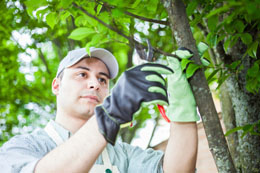Pruning a tree is not something that only experts can do. If the correct techniques are followed, then anyone can prune a tree. The following section gives more information on the same.

Pruning is a practice in horticulture that plays an important role in the growth and development of a plant or tree. The quality of flowers or fruits can be enhanced by this technique. It is also carried out for a variety of other reasons, such as removal of deadwood, removal of diseased or damaged parts of the tree to maintain its health, and to shape it for ornamental purposes, among others. There is a noticeable difference between the health of a tree that is regularly pruned and one that is not.
Techniques Adapted to Prune a Tree
Crown Raising: Crown raising is a technique in which the branches at the bottom of the crown are removed to provide some extra space underneath. It is also done to ensure that the branches do not cause any nuisance to those walking by, or create an obstruction for vehicles or buildings.
Crown Thinning: This technique is mainly used to prune hardwoods. It involves removal of certain branches to ensure increased air movement so that it reaches all parts of the crown, as well as to enhance the penetration of light.
Crown Reduction Crown reduction is usually done for trees that have grown too large. It is a technique that is avoided by the experts and recommended not to be used as it can result in tree decay and affect the health of the tree in an adverse way.
These pruning techniques are basically used by experts to maintain the large trees at public places and public gardens. They can also be used by those with home gardens, but a regular pruning regimen does not normally require cutting the topmost and bottommost crown of the tree altogether. Although pruning a tree helps in its health and growth, it causes a lot of stress to it. Hence, it is not advisable to prune more than 25% of the crown at one go, as it tends to increase the vulnerability of the tree to insects and tree diseases.
Steps to Trim a Tree
In simple terms, pruning means a procedure that involves getting rid of the unwanted branches of a tree whilst protecting its trunk, so that it can continue to grow normally even after being trimmed. Branches grow from the stem nodes and hence, pruning always needs to start from this point at the branch side. The branch and the trunk is divided by a tissue called a stem collar that grows from the stem at the base of the branch. This is where the trimming cuts need to be made for the sake of safety of the trunk or stem. While pruning, there is high risk of the stem wood and bark tearing off, especially if the branches are large. Given below are some tree trimming tips and procedures that can help in the prevention of tearing of the bark.
Step 1: On the branch side of the stem collar, make a small cut (wedge shaped) on the lower portion. Doing this will prevent tearing of the bark and the stem tissue from getting affected.
Step 2 From the top of the branch, cut through it in such a way that only a stub end remains.
Step 3: Make a cut parallel to the stem collar, in order to reduce the length of the stub end that was left in Step 2. Be careful while shortening the length of the stub as it might leave a wound on the bark.
It is important to prune a tree at the right time, as this helps in the healing process and also saves the tree from the insects that could cause it damage. Winter or late fall is the best time for this procedure. For deciduous trees, it is easier to trim them after they shed their leaves off, as their shape is easily noticeable. Flowering plants or trees can be trimmed at different times of the year, depending on the growth of flowers in the previous years. Dead branches should be removed at any time of the year, regardless of what season it is. However, it must be done as per the correct techniques. It is also advised to fertilize the tree after trimming, so that the post-pruning wounds do not take a long time to heal.






 Pruning is a practice in horticulture that plays an important role in the growth and development of a plant or tree. The quality of flowers or fruits can be enhanced by this technique. It is also carried out for a variety of other reasons, such as removal of deadwood, removal of diseased or damaged parts of the tree to maintain its health, and to shape it for ornamental purposes, among others. There is a noticeable difference between the health of a tree that is regularly pruned and one that is not.
Pruning is a practice in horticulture that plays an important role in the growth and development of a plant or tree. The quality of flowers or fruits can be enhanced by this technique. It is also carried out for a variety of other reasons, such as removal of deadwood, removal of diseased or damaged parts of the tree to maintain its health, and to shape it for ornamental purposes, among others. There is a noticeable difference between the health of a tree that is regularly pruned and one that is not.